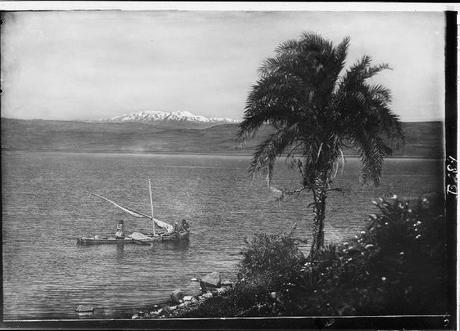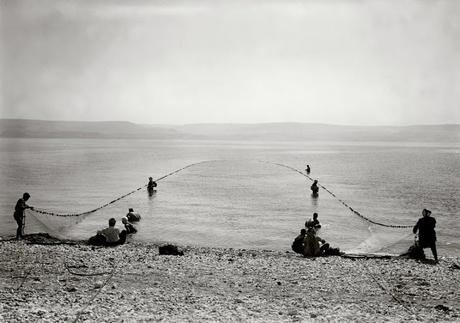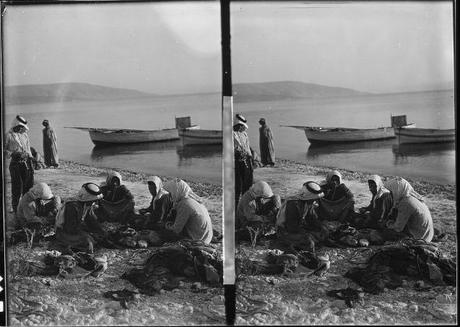I admire and respect fishermen. I've watched the hardy lobstermen of Maine, or the cod fishermen of Massachusetts, the watermen fishing for crabs in the Chesapeake, the shrimpers of the south or the bonefish, sponge, and conch fishermen of the warmer waters. Fishing for a living is hard. It is not for the weak or the lazy.
There are no days off, you go out in storms, heat, rain, and ice. You use your body as one with the boat and the sea, drawing from it food and life.
It was no different for the fishermen of Galilee in Jesus' day. Jesus called four fishermen as His disciples. Simon-Peter and his brother Andrew, and John and his brother James, the sons of Zebedee, who was also a fisherman.
Fishing villages along the shore of the Sea of Galilee included Capernaum, where Jesus based much of His ministry, (Mark 2:1); Bethsaida (Luke 9:10); and Magdala, town of Mary Magdalene (Matt 15:39).
The pictures of the Holy Land around 1900 are important because life and traditions in Palestine didn't change much until after WWI. A photo depicting life in 1900 would be almost a copy of any scene from the time of Jesus. These Library of Congress photos offer a glimpse into not just the recent past of the 20th century, but a peek back 2000 years.

Galilean fishing boat, around 1900. Source Library of Congress
While walking by the Sea of Galilee, he saw two brothers, Simon (who is called Peter) and Andrew his brother, casting a net into the sea, for they were fishermen. And he said to them, “Follow me, and I will make you fishers of men.” Immediately they left their nets and followed him. And going on from there he saw two other brothers, James the son of Zebedee and John his brother, in the boat with Zebedee their father, mending their nets, and he called them. Immediately they left the boat and their father and followed him. (Matthew 4:18-22).
We learn so much from just these 4 verses.
WHERE: They fished the Sea of Galilee
WHO: as mentioned, the two sets of brothers
WHAT: They were net fishermen as opposed to hook and line fishermen. They cast from boats they owned and they mended their nets (meaning they were diligent).
WHY: Fishing was hard, but gave a living, generationally, in John and James's case. Yet when He called, the men left their profession and immediately followed Jesus.
The Sea of Galilee was also called Kinneret or Kinnereth, and Lake Tiberias. It's Israel's largest freshwater lake. A fisherman's day would begin at pre-dusk, because they fished at night. Why? The nets were made of linen which were lighter colored. They'd be more visible to the fish by day, since the waters were cool and clear.
In addition, the fish were more active and feeding closer to the surface at night. You caught fish at night, in shallow water.
So they fished at night. (John 21:3). The men would launch their boat from shore and sail gently into the shallow areas along the shore. They'd cast their nets, which were really a three-walled net of decreasing size mesh holes, into the water. Little weights along the bottom would help the net sink vertically down, and the top would float, as there were little buoys of cork or wood attached.
They might be catching little fish, (Matthew 15:34), a Kinneret sardine, processed at the salting and drying station of the town of Bethsaida (House of Fish). Or they might be catching big fish, a kind of tilapia with white flesh and good to eat. (John 21:11).
If the fisherman wasn't using his boat or didn't have one, he stood near shore, casting a smaller net. When Jesus called Simon-Peter and Andrew, they were on the shore throwing out their nets from land. (Matthew 4:18). When He called James and John, they were throwing nets from their boat with their father Zebedee.
One other way to fish with nets was with a dragnet. Jesus compared dragnet fishing to the kingdom of heaven
Once again, the kingdom of heaven is like a dragnet that was cast into the sea and caught fish of every kind. (Matthew 13:47)
This is where a net would be laid out in a horseshoe shape from shore, and dragged in, catching many different kinds of fish. The men would then sort the good fish from the bad, tossing the unmarketable fish away and keeping the good.

Either way, the fisherman would swim to the center and dive down to gather either the fish or draw up the net. He'd do this naked. (Meaning with only his light undergarment on, not bare-skin naked). Peter was fishing this way when the verse says he put on his clothes to go meet Jesus. (John 21:7). The nets set from the boat could be several hundred feet long and 20 feet high. In Luke 5:6 when Jesus miraculously filled their nets, the huge nets became so heavy that they needed the other boat crew to help drag it aboard, then the nets were breaking, and the boat began to sink as they brought in the haul!
On a normal, miracle-less day, whether from the boat or from the shore, it still was heavy labor to throw the nets out, wait for them to settle, and then circle back by sail or swim back to haul them in. Repeat. All night. Fishermen were workers, strong, and usually were peasants and therefore used to a rough life.
In the morning, the fishermen would stop and bring their gear ashore. They'd stop for breakfast. Then they would set to fixing their gear. It was time to spread their nets and examine them. (Ezekiel 47:10). Do any of the stone weights along the bottom need replacing? They'd have to gather more stones, drill holes, and tie them to the bottom. Do any of the cork or wood buoys along the top need replacing? Do the nets need sewing? Are they rinsed off? Is the debris picked out of the nets?

Photo Library of Congress, Galilean Fishermen, approx 1900.
The same attention needs to be given to the boat. These items were their livelihood. So the fishermen would examine the sails and sew or patch any worn areas. Check the anchor and the mast and the underside. Tar or pitch could be heated to cover the planks to seal them. Ropes need to be re-twined and add pitch to the ends to ensure it doesn't fray.
At the end of their day they would fold the nets and store them in the boat, waiting for the night-time when they'd put out in the Sea of Galilee again.
A day in the life of a Galilean fisherman was hard, but it offered a living. As with any trade, a father taught the son. Joseph taught Jesus carpentry. Zebedee taught his sons James and John how to fish. Net fishing hasn't changed much in 2000 years. You could see similar scenes as the ones above in Indonesia, China, Viet Nam, Venezuela or any place. What has changed is the incarnation of Jesus, molding these rough outdoor peasant men into gentle, loving Christians, ready to catch men with the net of the Gospel. And as with these spiritual forefathers, they teach us to this day.
And Jesus said to Simon, "Do not be afraid; from now on you will be catching men." And when they had brought their boats to land, they left everything and followed him. (Luke 5:10b)
I pray you and I catch many souls with our net of the Gospel accompanied by a life well lived through following Him.
